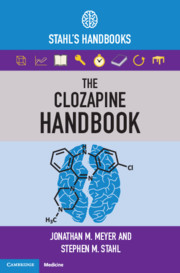Book contents
- The Clozapine Handbook
- The Clozapine Handbook
- Copyright page
- Additional material
- Contents
- Foreword
- Introduction
- 1 The Efficacy Story: Treatment-Resistant Schizophrenia, Psychogenic Polydipsia, Treatment-Intolerant Schizophrenia, Suicidality, Violence, Mania and Parkinson’s Disease Psychosis
- 2 Addressing Clozapine Positive Symptom Nonresponse in Schizophrenia Spectrum Patients
- 3 Initiating Clozapine
- 4 Discontinuing Clozapine and Management of Cholinergic Rebound
- 5 Binding Profile, Metabolism, Kinetics, Drug Interactions and Use of Plasma Levels
- 6 Understanding Hematologic Monitoring and Benign Ethnic Neutropenia
- 7 Managing Constipation
- 8 Managing Sedation, Orthostasis and Tachycardia
- 9 Managing Sialorrhea
- 10 Managing Seizure Risk and Stuttering
- 11 Managing Metabolic Adverse Effects
- 12 Fever, Myocarditis, Interstitial Nephritis, DRESS, Serositis and Cardiomyopathy
- 13 Managing Enuresis and Incontinence, Priapism, Venous Thromboembolism, Neuroleptic Malignant Syndrome, Tardive Dyskinesia and Obsessive Compulsive Disorder
- 14 Eosinophilia, Leukocytosis, Thrombocytopenia, Thrombocytosis, Anemia, Hepatic Function Abnormalities
- 15 Special Topics: Child and Adolescent Patients, Elderly Patients, Patients With Intellectual Disability, Pregnancy and Risk for Major Congenital Malformation, Lactation, Overdose, Postmortem Redistribution
- Index
- References
12 - Fever, Myocarditis, Interstitial Nephritis, DRESS, Serositis and Cardiomyopathy
Published online by Cambridge University Press: 19 October 2021
- The Clozapine Handbook
- The Clozapine Handbook
- Copyright page
- Additional material
- Contents
- Foreword
- Introduction
- 1 The Efficacy Story: Treatment-Resistant Schizophrenia, Psychogenic Polydipsia, Treatment-Intolerant Schizophrenia, Suicidality, Violence, Mania and Parkinson’s Disease Psychosis
- 2 Addressing Clozapine Positive Symptom Nonresponse in Schizophrenia Spectrum Patients
- 3 Initiating Clozapine
- 4 Discontinuing Clozapine and Management of Cholinergic Rebound
- 5 Binding Profile, Metabolism, Kinetics, Drug Interactions and Use of Plasma Levels
- 6 Understanding Hematologic Monitoring and Benign Ethnic Neutropenia
- 7 Managing Constipation
- 8 Managing Sedation, Orthostasis and Tachycardia
- 9 Managing Sialorrhea
- 10 Managing Seizure Risk and Stuttering
- 11 Managing Metabolic Adverse Effects
- 12 Fever, Myocarditis, Interstitial Nephritis, DRESS, Serositis and Cardiomyopathy
- 13 Managing Enuresis and Incontinence, Priapism, Venous Thromboembolism, Neuroleptic Malignant Syndrome, Tardive Dyskinesia and Obsessive Compulsive Disorder
- 14 Eosinophilia, Leukocytosis, Thrombocytopenia, Thrombocytosis, Anemia, Hepatic Function Abnormalities
- 15 Special Topics: Child and Adolescent Patients, Elderly Patients, Patients With Intellectual Disability, Pregnancy and Risk for Major Congenital Malformation, Lactation, Overdose, Postmortem Redistribution
- Index
- References
Summary
Managing clozapine-treated patients requires clinicians to become familiar with specific medical concerns not typically seen with other antipsychotics. Among the many unique adverse events associated with clozapine treatment is a constellation of fever and immune-mediated pathologies including myocarditis, interstitial nephritis, serositis and drug reaction with eosinophilia and systemic symptoms (DRESS). While the onset of fever during the first weeks of clozapine treatment is a common and often benign occurrence, swift action is necessary with the goal of recognizing and addressing more serious issues or minimizing a treatment interruption when evidence for systemic problems is lacking. The latter concept is important, as fever during the first weeks of therapy may appear in approximately 20% of patients, and therefore is not a reason to permanently discontinue clozapine treatment when there is no evidence for myocarditis, interstitial nephritis, or other systemic drug reactions. Cardiomyopathy is another unusual clozapine-related syndrome that is typically a later development, but presents a distinct group of clinical and ethical challenges when clozapine withdrawal fails to induce meaningful improvements in left ventricular ejection fraction (LVEF). Through a greater understanding of the time course and phenomenology of fever, myocarditis, interstitial nephritis, serositis, DRESS and cardiomyopathy clinicians can make evidence-based decisions about withholding clozapine treatment, and when resumption or rechallenge appears feasible.
- Type
- Chapter
- Information
- The Clozapine HandbookStahl's Handbooks, pp. 224 - 241Publisher: Cambridge University PressPrint publication year: 2019

